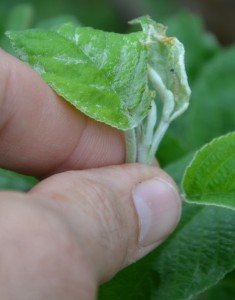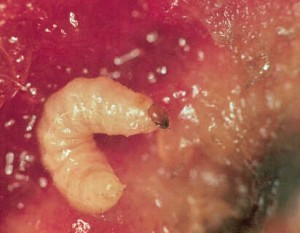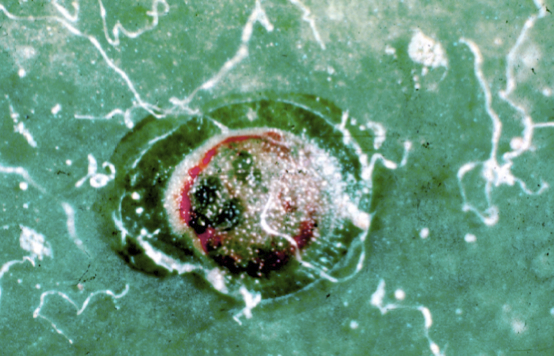Plum Curculio Migration and Fruit Injury; Codling Moth Management: Mid-Hudson Valley Update
May 27th, 2014
Scouting: In untreated trees at the Hudson Valley Lab in Highland, NY, we are seeing increasing signs of lepidopteran larva feeding on foliage and fruit (RBLR, OFM and OBLR). The Obliquebanded Leafroller (OBLR) are now well protected in terminal tips. 

Plum Curculio (PC): 


Applications using effective insecticides against plum curculio should control the pest for about 10-14 days based on materials and weathering.
Frequent short interval rains will remove surface contact insecticide residual. Incidence of observed PC damage is highly variable among different orchards. PC damage often occurs in the same locations in orchards year after year, regardless of treatment levels with the potential for damage in any particular orchard fairly predictable from past observations.
Insecticides effective against the PC include Avaunt 30WDG (indoxacarb), the neonicotinoids; Actara 25WDG (thiamethoxam), Calypso 4F (thiacloprid), the OP Imidan 70WP, WSP (Phosmet), carbamate; Sevin (carbaryl), and pyrethroids Danitol 2.4EC (fenpropathrin), Asana XL (esfenvalerate), Baythroid XL 1E, 2EC (beta-cyfluthrin), Lambda-Cy 1CS (lambda-cyhalothrin), Warrior 1CS (lambda-cyhalothrin), Proaxis 0.5CS, and pre-mix formulations Endigo ZC (lambda-cyhalothrin / thiamethoxam), Leverage 360 (imidacloprid / beta-cyfluthrin), Gladiator (zeta-cypermethrin / avermectin), Voliam Express (lambda-cyhalothrin / thiamethoxam), Voliam Flexi (chlorantraniliprol / thiamethoxam). This will be the last year for use of Calypso 4F, one of the better OP replacement materials for PC management.
The pyrethroids and phosmet have broad spectrum activity to include PC, EAS, lepidopteran larva (OFM, CM, Lesser appleworm (LAW) and Obliquebanded leafroller (OBLR). They have no activity against rosy apple aphid (RAA) in curled foliage.
Calypso 4F has activity against PC, EAS, RAA, leafhopper and leafminer, internal lepidopteran (OFM, LAW and CM) but only moderate to low activity against the OBLR.
 adults have been captured in Highland on the 19th of May. Many insecticides used against the PC will manage the CM larva. However, Actara, a good PC material at the high labeled rate, will have no efficacy against the CM larva, allowing larva to get a foothold in the orchard. In blocks where this insect has been problematic choosing insecticide with efficacy against PC and CM should be strongly considered (Rated as highly effective against both PC and CM: Calypso, Imidan, Leverage, Voliam Flexi and Voliam Xpress). If additional applications for CM are needed after migration of PC is complete, the use of CM specific insecticides can be employed such as Altacor, Assail, Belt, Delegate, Lannate, and the pyrethroid group.
adults have been captured in Highland on the 19th of May. Many insecticides used against the PC will manage the CM larva. However, Actara, a good PC material at the high labeled rate, will have no efficacy against the CM larva, allowing larva to get a foothold in the orchard. In blocks where this insect has been problematic choosing insecticide with efficacy against PC and CM should be strongly considered (Rated as highly effective against both PC and CM: Calypso, Imidan, Leverage, Voliam Flexi and Voliam Xpress). If additional applications for CM are needed after migration of PC is complete, the use of CM specific insecticides can be employed such as Altacor, Assail, Belt, Delegate, Lannate, and the pyrethroid group.
The first eggs hatch after about 220 DD, which is predicted to occur 3 June. Insecticides that need to be present before egg laying such as (Rimon, applied at about 50-75 DD) are not a good choice at this time given the number of eggs already on the foliage. Insecticides that target the egg laying and hatch period should be applied at the next available window.
Use of pre-mix formulations containing multiple active ingredients (A.I.) should take into account the need for the A.I. during the remainder of the season so as to ‘need’ both A.I.’s and monitor usage within labeled seasonal amount restrictions. For example, if use use Voliam Flexi or Voliam Xpress, the A.I. chlorantraniliprole may prohibit the use of Altacor (A.I. chlorantraniliprole) later in the season for OBLR.



